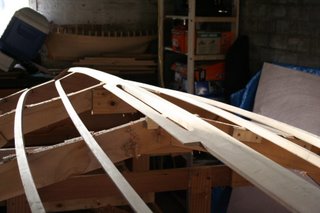I started with the varnish work first on the basis that I could paint over varnish but not vice versa.
 |
| From Painting and Varnishing - Penobscot 14 |
To start with I sealed the hull inside and out with two coats of epoxy. This was sanded down once dry and hard to give a smooth surface for the varnish. In hindsight I should have also filled some of the small gaps with coloured epoxy. This is made with a combination of glue filler and wood flour in the epoxy to get the right colour. Now, over a year down the track the varnish is starting to deteriorate from the edge of these gaps. The inside of the hull and transom was given five coats of varnish.
 |
| From Painting and Varnishing - Penobscot 14 |
I then flipped her over and started by sanding the epoxy coats and then applied two coats of primer. I used the International Interlux paint system which is a single pot paint and give a good finish with just roller and brush.
At this point I erected a very big tarp that I held aloft with a number of tent poles and ropes. After the primer I gave the hull a light sand and filled some of the little dents etc that seems to stand out at this point even though it was checked carefully at the previous stage. Next two coats of undercoat, sand again and then three final coats with a light sand after the second of these.
 |
| From Painting and Varnishing - Penobscot 14 |
To promote good chemical bonds I ensured that there was only about 24 hours between coats which required me to rise early before work and apply a coat to start the day. When a coat was to be sanded I would leave it a bit longer to allow it to be a bit harder.
 |
| From Painting and Varnishing - Penobscot 14 |
In the photo above you can see the masking on the transom. The paint needs to cover the end of the ply on the plank. I decided to make the planks look about 10mm think by masking inside the planks which I think looks better that having the thinner 6mm of the plank and definitely better than having the paint not follow the planks.
All up the finishing did not take that long but it did require a dedicated three weeks of work each and every day. This is not something easily done on weekends as per my usual work schedule.
 |
| From Painting and Varnishing - Penobscot 14 |


















 Now with that done it is time for a drink all round.
Now with that done it is time for a drink all round.
 Next I marked on the rudder the cutout for the tiller and the bottom edge of the cheeks. I then attached the cheeks to the rudder with screws above and below the tiller slot and then trimmed the cheeks to shape using the router. I then removed the cheeks and used the bandsaw to cut the rudder into its three peices.
Next I marked on the rudder the cutout for the tiller and the bottom edge of the cheeks. I then attached the cheeks to the rudder with screws above and below the tiller slot and then trimmed the cheeks to shape using the router. I then removed the cheeks and used the bandsaw to cut the rudder into its three peices. Here is the end of my tiller. Probably a bit much for a small boat but it was a bit of fun doing it.
Here is the end of my tiller. Probably a bit much for a small boat but it was a bit of fun doing it.






















